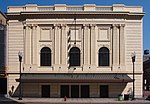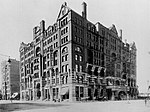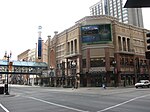Unique Theater
1904 establishments in Minnesota1943 disestablishments in MinnesotaBuildings and structures demolished in 1943Cinemas and movie theaters in MinnesotaDemolished buildings and structures in Minnesota ... and 3 more
Demolished theatres in the United StatesTheatre in MinneapolisTheatres completed in 1904

The Unique Theater was an 830-seat vaudeville theater, built in 1904 on Hennepin Avenue in downtown Minneapolis, Minnesota. It was built in the Renaissance Revival style, and situated between the Hennepin Center for the Arts and the West Hotel. The hotel catered to a family audience with daily performances priced at ten or twenty cents.
Excerpt from the Wikipedia article Unique Theater (License: CC BY-SA 3.0, Authors, Images).Unique Theater
Hennepin Avenue, Minneapolis
Geographical coordinates (GPS) Address Nearby Places Show on map
Geographical coordinates (GPS)
| Latitude | Longitude |
|---|---|
| N 44.979305555556 ° | E -93.273611111111 ° |
Address
Hennepin Center for the Arts
Hennepin Avenue
55403 Minneapolis
Minnesota, United States
Open on Google Maps









